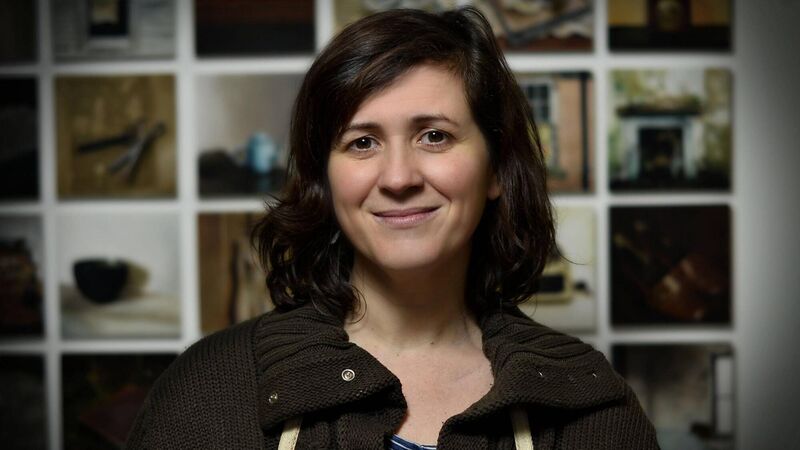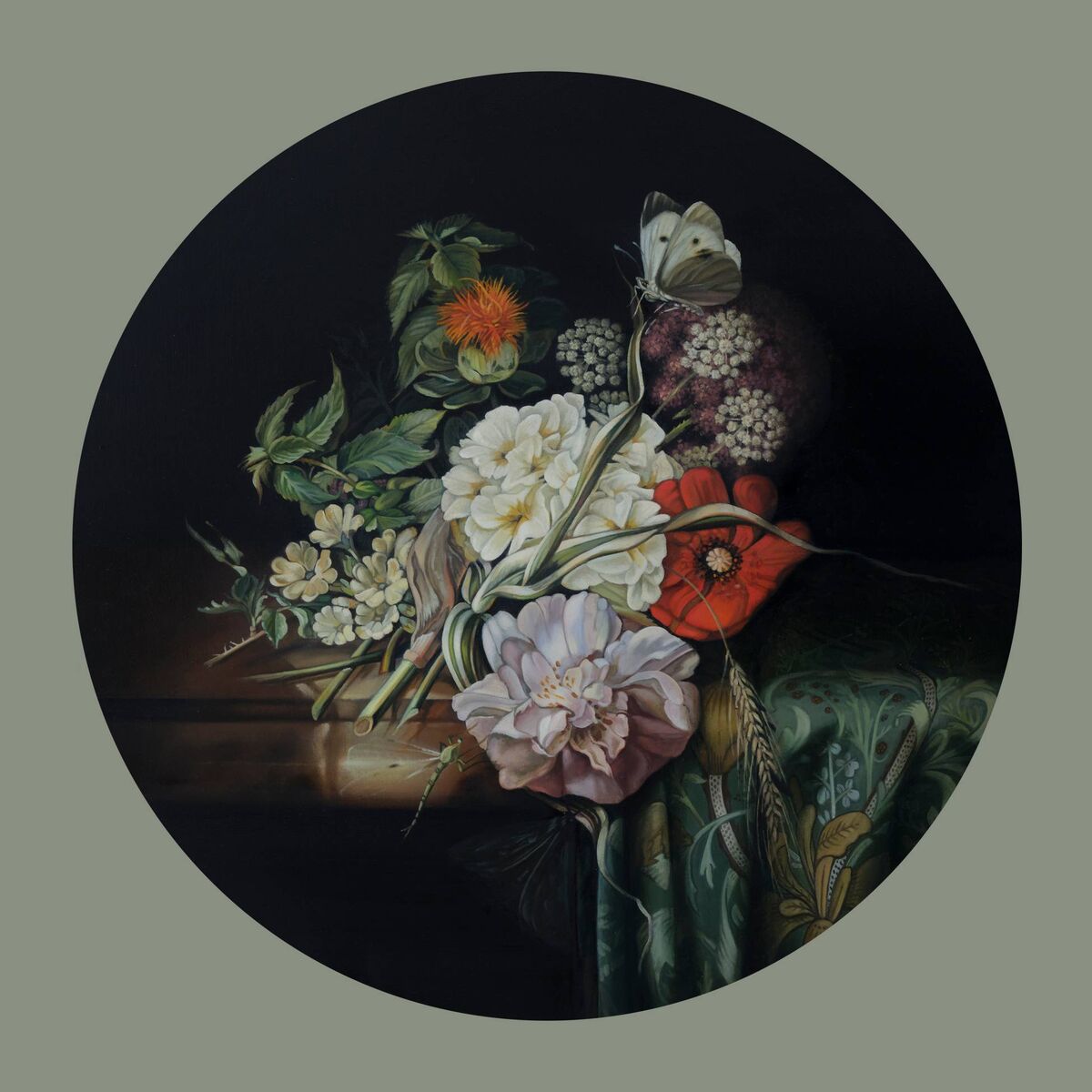Jennifer Trouton: Tackling the theme of abortion through flowers in her art

Jennifer Trouton is part of the current exhibition at the Lavit gallery in Cork. Picture: Russell Pritchard/Presseye
Jennifer Trouton’s contribution to the New Irish Art exhibition currently showing at the Lavit Gallery in Cork is a single round painting in oils. Like all her work, it is meticulously crafted, a botanical study whose subversive intent is only really suggested by its title, Bring Down the Flowers III. The phrase is a Victorian euphemism for inducing a miscarriage. “An abortion, in other words,” says Trouton.
The painting, like its companions, Bring Down the Flowers I and II, is inspired by the work of the 18th century Dutch artist Rachel Ruysch. “She was the most successful botanical painter of her time. She outsold her male counterparts, became a court painter to Marie Antoinette, and lived well into her 80s, so she had a very prolific career. She was also a mother of ten. But her male counterparts are the ones whose history is recorded and remembered, and they’ve had all the shows. It’s only now that Ruysch is coming back to prominence. I really admire her.”
Trouton has herself been drawing and painting since the age of five. “I’m a country girl,” she says. “I grew up near Portadown in Co Armagh. I drew and painted, and I read; those were the three things I did as a kid. I started by copying the pictures in my mom’s house. And one day, when I was eight or nine, I said, I’m going to art school. I didn’t even know what an art school was, or whether such a thing existed. But when Fame: The Movie came out, I discovered there were real places you could go to study art. I would have gone to New York if I had to. I never had a Plan B. Ever.”
Thankfully, she found a college closer to home, in the shape of the University of Belfast, where she completed her fine art degree. “I was there in the late 1980s and early 1990s, the Brit Art era. It wasn’t really in vogue to teach painting, it was very much about concept over all else.”
Trouton still lives in Belfast, working at a studio just five minutes from home. “I only really learned some basics at art school,” she says. “Otherwise, I’ve taught myself. My work’s labour intensive. I’m a nine-to-fiver, and where I’m at now has come through daily practice.”

Women’s reproduction and abortion have been themes for some time now, notably so in one of Trouton’s most ambitious works, the suite of 32 watercolour paintings that comprise Mater Natura: The Abortionist’s Garden. They were begun in 2020 and completed the following year, when the Crawford Art Gallery in Cork bought the series for the National Collection. At first glance, they look like very pretty botanical studies, but closer inspection reveals they all feature herbs or plants that have traditionally been used to induce abortion, along with maps of Ireland and drawings of the female pelvis and uterus.
“In 2014, my husband started a PhD on the subject of abortion in Northern Ireland,” says Trouton. “It took him six months to get access to the court records, but he read every single case of the women, pharmacists and doctors who'd been prosecuted or had come to court in relation to abortion between 1921 and 1968. He was coming home and telling me their stories. Stories of how little girls aged five and six would find their mommies dead on the floor, because they were having unsafe illegal abortions.
"Many women who tried to access abortion were mothers who already had large families, or had hard economic situations or were in difficult marriages. Sometimes they had major underlying health issues, and knew that having another child would probably kill them. But they had illegal abortions because there was no legal recourse for them to end their pregnancies.
“We had our son that same year. So I was at home, on maternity leave, and I had started making new work, but tentatively. And I thought, I need to bring these voices out of the archive. There's no memorials for these women. It’s like, fallen soldiers are heroes, but fallen women are Jezebels, you know?”
Trouton acknowledges that her need to make work about abortion was partly because “it was my lived experience when I was 17. It's something I had never spoken about. My husband knew, and maybe one or two girlfriends. I was quite embarrassed to think that I was, at that time, a 40-something-year-old woman who had fallen into the shame and stigma of never speaking about it. But something in me went, no, I need to make work about this. I need to make work that's quiet and gentle, but powerful as well. Work that would alienate no one, but would make everyone rethink what they thought they knew about the domestic space and what women have had to go through in the home to control their bodies."
At the beginning Trouton says she joked that she wanted to make work that the DUP would like. "They’d come up and go, oh, look at that beautiful little painting of an enamel bowl, my granny had one like that. They'd be brought in by the familiarity of all those objects. But really what they're looking at has a very dark understory. It's about how all these everyday innocuous objects were becoming tools in a war for women to control their bodies. And obviously one of the things that women used a lot of was plants and herbs.”
In several of her works, Trouton includes a herbal recipe to induce abortion that was recorded in the 12th century by Trotula of Salerna, said to have been the first female gynaecologist in Europe. It’s there in the Bring Down the Flowers series, printed on the fabric on which the flowers rest. “I’ve replaced some of the flowers Ruysch had in her original paintings with others that came up in my research. And I’ve included moths because they’re laden with symbolism within Irish culture. A moth coming into the house is meant to be a visiting soul.”
Trouton is currently working towards a large exhibition at the Ulster Museum in 2027. There’s a huge painting on her easel that she expects will take a year to complete, a composition that will feature all 32 of the plants featured in Mater Natura: The Abortionist’s Garden.
“I’ll be blocking it out for the next few months,” she says. “There’s days I look at it and go, I don’t really know what I’m doing, I’m the worst painter in the world. But then I’ll paint more layers, and eventually it might begin to look like something. It takes time. Time and patience.”
- New Irish Art runs at the Lavit Gallery in Cork until September 27, and features work by John Behan, Tom Climent, Cecilia Danell, Nuala O’Donovan, Deirdre Frost, Kaye Maahs, Samir Mahmood, Louise Neiland, Martha Quinn, Jennifer Trouton, Dominic Turner, Amna Walayat and Conor Walton




